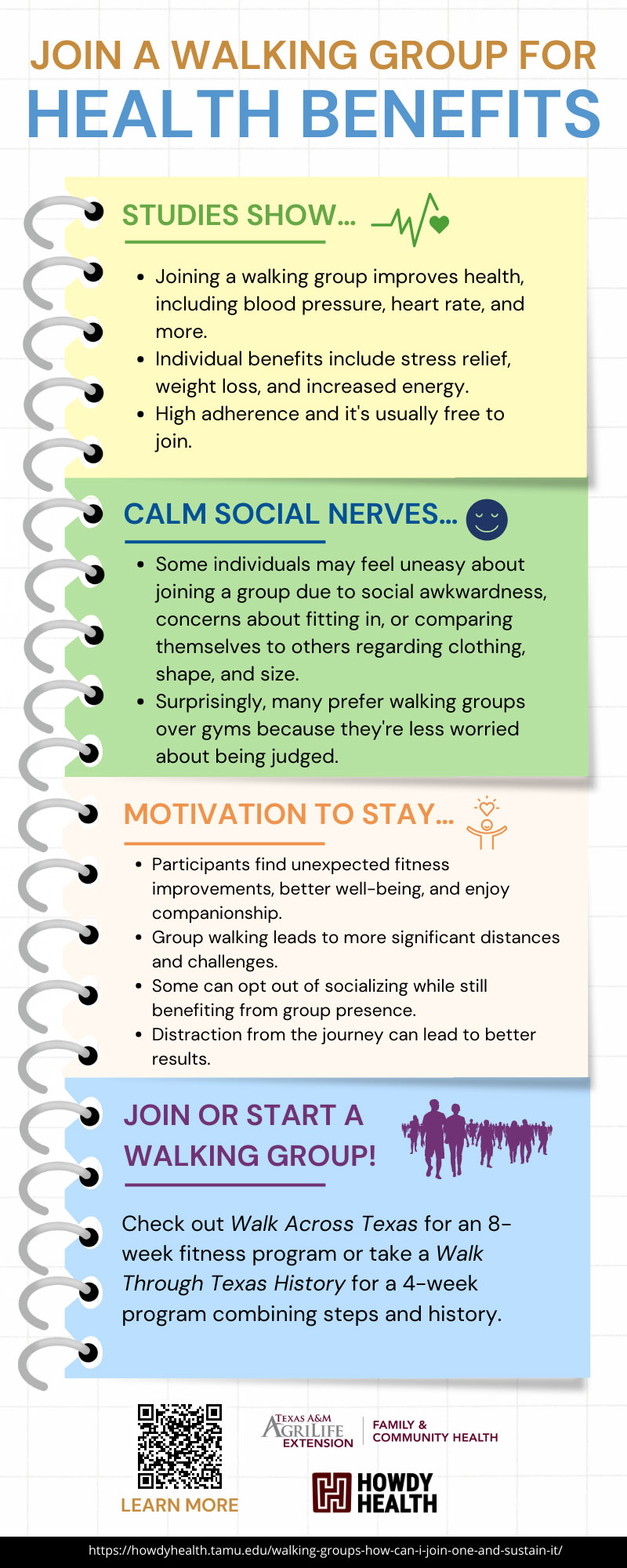Joining a walking group might be just what you’re looking for to meet your health goals… and you might find some unexpected results along the way. In fact, even if you don’t consider yourself very social, you may still find benefits in joining a walking group.
What Studies Say About Walking Groups
Most people initially join a walking group because they want to reach a health goal. Studies of walking groups have found a wide range of health benefits including improvements in:
- Blood pressure
- Heart rate
- Body fat
- Body mass index (BMI)
- Total cholesterol
- Oxygen uptake
- Walking time
- Risk for depression
- Quality of life.1
Individuals who have taken part in walking groups have expressed:
- Improved breathlessness
- Weight loss
- Stress relief, a calming experience2
- Feeling a sense of getting away2, a haven away from everyday life3
- Feeling more energized and confident
- Feeling a sense of purpose
- Feeling a sense of accomplishment
- Looking forward to the positive effect felt after the walk.2
Additionally, walking groups tend to have high adherence – in other words, people tend to stick with it, and low risk of serious adverse effects.1 Plus, walking groups are almost always free!
Let’s Get Real – Social Apprehension
Does thinking about joining a group make you uneasy? You’re not alone. When thinking about joining a walking group, participants in studies of walking groups have expressed concern about:
- Social awkwardness
- The first session being a hurdle to be crossed
- Concern about fitting in
- Others not looking as they do, including:
- Clothing worn
- Shape and size.2
Interestingly, in one study participants chose walking in a group as their preferred option over joining a gym because they were less concerned about being judged.3 In another group, “There was a general relief that no-one wore fitness clothing and that others looked as they did in all shapes and sizes.”2
So, if joining a group makes you feel apprehensive, just remember, you’re not alone and read on to hear what some who’ve gone before you have found out!
Unexpected Results – Motivation to Stay
While most people would say they joined a walking group to reach their physical health goals, some of the reasons they chose to stay in a walking group may surprise you…
- Surprise at actual results. Though participants joined the group with the hope of reaching health goals, some were truly surprised to find they could breathe easier and feel their pants getting a little looser with continued participation. Though they hoped to lose weight and gain fitness, they had low expectations that walking regularly with a group would really help.2
- Impact on everyday life, improved well-being. Physiological changes, such as being better able to walk and talk without feeling out of breath and feeling more energized carried over into the rest of their day and improved their quality of life.2
- Enjoyment of the activity for its own sake. Whether for companionship, conversation, fun and enjoyment with others, or for time to think, reduce stress, and bring on a sense of calm or contentment, participants came to enjoy walking as a group for its own sake, not just to reach their health goals.2,4
- Further and faster. In one study, all participants felt they walked further and faster due to the influence of others. They observed the speed of others and were able to judge their own improvements by comparison.2
- Challenge that can be individualized. Walking further or faster was not seen as being pushed, but a challenge that could be individualized. Distance was added with switch backs in the route that could be added or not. A choice of more difficult terrain was also an option, which could extend their route, but then allow for looping back to the group. While some participants would go in these different directions, participants could choose their speed, distance, and terrain without being fully separated from the group.2 In another study, built in halts to look at a view or natural stops to move over and around something, like a road or ditch, allowed for different paces, so those in the back of the group could catch up, allowing the group to stay together, while walking at different paces.4
- Opting out of the social aspect. Creating space between participants and choosing to stay back or push forward, allowed those who appreciated having the presence of the group2 (e.g., for accountability, motivation, and/or a feeling of safety and security)4 to participate without having to actively socialize.2
- The beauty of distraction. The groups studied enabled enjoyment and companionship,2,4 which also resulted in distraction from the strain of walking.2 What a wonderful surprise when we realize we’ve gone further or faster than we expected, simply because we were distracted by the enjoyment of others and our journey!
Whatever your reasons for seeking a walking group, the presence of others might help you sustain involvement, form new habits, and stretch your personal goals!
Join or Start a Walking Group Today
If you’re looking to join or even start a walking group, here are two ways to do that right now!
- Walk Across Texas. You can start or join a Walk Across Texas team. Walk Across Texas is a free, 8-week program designed to help you establish the habit of regular physical activity. Each adult team may include up to 8 team members, all working together to walk the 832-mile goal.
To start a team, gather up to 8 people (7 + you) or contact your local Texas A&M AgriLife Extension office to see if they have an ongoing program with a team that you can join. Each of the team members will log the miles they walk each week for 8 weeks. You can walk together with one or more members of your team or exercise on your own – it’s your choice. The idea is to encourage one another to be physically active and form active habits for 8 weeks and beyond. Once the 8 weeks are over, you simply fill out a short wrap-up form and you can begin again for another 8 weeks.
- Walk Through Texas History. If you prefer step counting to logging miles, or you’d like to learn a little Texas history as you log your physical activity, come join our Walk Through Texas History Program. Walk Through Texas History is a free, 4-week program designed to help you establish the habit of regular physical activity while learning the rich history of Texas. Each adult team may include up to 8 team members, all working together to reach designated goals while following along legendary Texas historical paths.
To start a team, gather up to 8 members (7 + you) or contact your local Texas A&M AgriLife Extension office to see if they have an ongoing program with a team that you can join. The idea is to work together towards the goal of virtually walking along a historical route. Each team member logs steps in our online challenge tracker that contribute toward the team’s mileage total. You can walk together with one or more members of your team or on your own – it’s your choice. Once the 4 weeks are over, you simply fill out a short wrap-up form and you can begin again for another 4 weeks. You can even choose a new historical route!
Infographic
Download the PDF or share the image below to help others join a walking group for health benefits.
Join a Walking Group for Health Benefits – Infographic (pdf)
- Hanson, Sarah, and Andy Jones. “Is There Evidence That Walking Groups Have Health Benefits? A Systematic Review and Meta-Analysis.” British Journal of Sports Medicine, vol. 49, no. 11, 2015, pp. 710–715., https://doi.org/10.1136/bjsports-2014-094157.
- Hanson, Sarah, et al. “Walking Groups in Socioeconomically Deprived Communities: A Qualitative Study Using Photo Elicitation.” Health & Place, vol. 39, 2016, pp. 26–33., https://doi.org/10.1016/j.healthplace.2016.02.007.
- Pollard, Tessa M., et al. “Communal Therapeutic Mobility in Group Walking: A Meta-Ethnography.” Social Science & Medicine, vol. 262, 2020, p. 113241., https://doi.org/10.1016/j.socscimed.2020.113241.
- Grant, Gordon, et al. “Walking, Sustainability and Health: Findings from a Study of a Walking for Health Group.” Health & Social Care in the Community, vol. 25, no. 3, 2017, pp. 1218–1226., https://doi.org/10.1111/hsc.12424.






